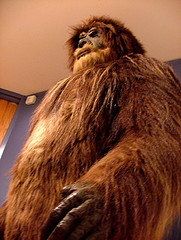Where is Cassie?
Posted by: Loren Coleman on October 4th, 2006

I look forward to seeing folks at the closing reception at Bates’s exhibition “Cryptozoology: Out of Time Place Scale,” on October 7th.

In the meantime, I will be pondering why it has been so many years since anyone has seen Cassie, the Casco Bay Sea Serpent. Cassie, the local name I coined long ago in a magazine to characterize these cryptids seen near Portland, Maine, was bestowed in the same tradition that many freshwater and marine creature monikers are given – with passion, humor, and a nod to Nessie. As it turns out, of course, Portland is not alone in missing its Sea Serpents.
“All Things Maine” blogger Christopher Dunham gave a nice overview of “The Sea Serpents of Mount Desert Island” a year ago in his essay.
Chris reprinted the text of old newspaper articles detailing sightings off Mount Desert Island from 1793, 1819, 1827, and 1836. I certainly appreciate him recommending my and Patrick Huyghe’s field guide on the subject as a good book to have along on your Sea Serpent search. His material pointed out, once again, that these bygone days had more sightings along the coast than we have experienced of late. Too bad.
Where is Cassie?
About Loren Coleman
Loren Coleman is one of the world’s leading cryptozoologists, some say “the” leading living cryptozoologist. Certainly, he is acknowledged as the current living American researcher and writer who has most popularized cryptozoology in the late 20th and early 21st centuries.
Starting his fieldwork and investigations in 1960, after traveling and trekking extensively in pursuit of cryptozoological mysteries, Coleman began writing to share his experiences in 1969. An honorary member of Ivan T. Sanderson’s Society for the Investigation of the Unexplained in the 1970s, Coleman has been bestowed with similar honorary memberships of the North Idaho College Cryptozoology Club in 1983, and in subsequent years, that of the British Columbia Scientific Cryptozoology Club, CryptoSafari International, and other international organizations. He was also a Life Member and Benefactor of the International Society of Cryptozoology (now-defunct).
Loren Coleman’s daily blog, as a member of the Cryptomundo Team, served as an ongoing avenue of communication for the ever-growing body of cryptozoo news from 2005 through 2013. He returned as an infrequent contributor beginning Halloween week of 2015.
Coleman is the founder in 2003, and current director of the International Cryptozoology Museum in Portland, Maine.










The romantic in me would love to believe that there were more sea monsters in the past, but the more logical side of me keeps yammering that there were simply more mis-identifications of what WERE unknown animals (at that point in history)
However, if taken as literal truth (that there were more true monsters then) perhaps it has something to due with the environmental changes? Change in migration of food supply; change in salinity or currents; upswing of polutants and sewage in coastal waters.
The possibilities are nearly limitless.
Yes, there are a lot of reasons why these creatures, if they ever existed, would have dissappeared. Maybe pollutants, environmental changes, etc. I hate to say it, but they may even have become extinct before ever really being discovered. I often wonder about animals that have died out before being found by science and officially recognized. The fact that there are not really any sightings these days makes me suspect that this is the case here. Wonder if we will ever know what was really going on over there?
Also, the idea that most people are on boats or ships that make considerable noise and often travel in specific shipping lanes can account for some lack of reports. After all, when Thor Heyerdahl and his mates completed the Kon Tiki tour, he mentioned experiencing some unknown large creatures that weren’t whales. They never did discover what they were. But the reason they may have had these encounters at all is that they were floating slowly, and silently on a raft for many miles
Anyone out there offering a grant to study the effects of global warming on cryptids?
You never know Loren. Much like some of the ‘rediscovered’ animals you posted about last week, perhapd Cassie will rear its head again some day.
Personally, I think there would have to be less Sea Monsters around today than there were in the 19th and early 20th centuries, for the simple fact that there is less of everything else out there in the oceans today.
Take Sea Turtles, which are pretty big, but clearly dwarfed by most Sea Monsters. All but one species of Sea Turtle is endangered, and the one that isn’t is considered threatened. The largest of them, the Leatherback, is in fact critically endangered.
When environments are altered, whether by natural calamity or man-made influence, the animals most effected are the ones that require the most food. Leatherbacks, some of them the size of Volkswagens, will die off before Loggerheads (Which reach a top weight of only 400 pounds or so), because they cannot find enough food, while the smaller ones are still able to eke out an existence.
In the extreme circumstance of the K-T extinction 65 MYA, the largest animals, the Dinosaurs, died out, while much smaller ones such as turtles, crocodilians, rodents, fish, insects, and so on lived on.
Odds are good that if they exist, Sea Monsters are endangered through most of their former range, their population levels hovering around that of the average species of whale (Less, of course, if they feed off of whales).
I’m going with a combination of big noisy boats and a drop in populations, though I would like to think the first is the main reason.